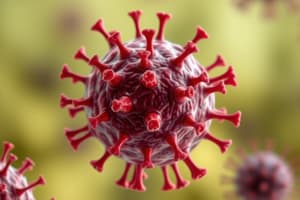Podcast
Questions and Answers
What is the main difference between active and passive immunity?
What is the main difference between active and passive immunity?
- Active immunity provides immediate protection, while passive immunity develops gradually.
- Active immunity involves the individual's immune response, while passive immunity involves transferred antibodies. (correct)
- Passive immunity is exclusively acquired through vaccines.
- Active immunity is temporary and passive immunity is long-lasting.
Which immunoglobulin class is primarily responsible for activating the complement system?
Which immunoglobulin class is primarily responsible for activating the complement system?
- IgG
- IgM (correct)
- IgA
- IgE
What characterizes the constant regions of an antibody?
What characterizes the constant regions of an antibody?
- They provide flexibility for the antibody to adapt to various antigens.
- They have a unique structure for binding specific antigens.
- They determine the antibody's class and effector functions. (correct)
- They are the only regions that can change in response to an antigen.
Which immunoglobulin class is predominantly found on mucosal surfaces to prevent pathogen adherence?
Which immunoglobulin class is predominantly found on mucosal surfaces to prevent pathogen adherence?
What happens during the clonal expansion of T-cells in the cell-mediated immune response?
What happens during the clonal expansion of T-cells in the cell-mediated immune response?
Which of the following is an example of natural passive immunity?
Which of the following is an example of natural passive immunity?
T-cells are primarily activated when they encounter antigens presented by which type of cells?
T-cells are primarily activated when they encounter antigens presented by which type of cells?
Which immunoglobulin class is associated with allergic reactions and responds to parasites?
Which immunoglobulin class is associated with allergic reactions and responds to parasites?
What is the predominant role of cell-mediated immunity?
What is the predominant role of cell-mediated immunity?
Which of the following statements about natural immunity is correct?
Which of the following statements about natural immunity is correct?
What is the primary purpose of T-cell maturation in the thymus?
What is the primary purpose of T-cell maturation in the thymus?
Which step of the immune response follows amplification?
Which step of the immune response follows amplification?
What characterizes primary immunodeficiency?
What characterizes primary immunodeficiency?
What happens when B-cells are activated by an antigen?
What happens when B-cells are activated by an antigen?
What is one consequence of failure in the negative selection of T-cells?
What is one consequence of failure in the negative selection of T-cells?
Which of the following is NOT a source of iatrogenic immunodeficiency?
Which of the following is NOT a source of iatrogenic immunodeficiency?
During which phase of the immune response is memory T-cell formation emphasized?
During which phase of the immune response is memory T-cell formation emphasized?
Which cells are generated by B-cells during their maturation process?
Which cells are generated by B-cells during their maturation process?
How does innate immunity primarily differ from adaptive immunity?
How does innate immunity primarily differ from adaptive immunity?
Which of the following correctly orders the five phases of the immune response?
Which of the following correctly orders the five phases of the immune response?
What role do memory T-cells play during a secondary exposure to a pathogen?
What role do memory T-cells play during a secondary exposure to a pathogen?
Which of the following is NOT a key component of innate immunity?
Which of the following is NOT a key component of innate immunity?
Which statement accurately describes the role of cytokines in the immune response?
Which statement accurately describes the role of cytokines in the immune response?
What is the primary function of chemokines in the immune system?
What is the primary function of chemokines in the immune system?
Which characteristic is specific to an immunogen rather than an antigen?
Which characteristic is specific to an immunogen rather than an antigen?
Which type of immunity is primarily responsible for combating viral infections?
Which type of immunity is primarily responsible for combating viral infections?
What is the role of acute phase proteins in the immune response?
What is the role of acute phase proteins in the immune response?
Which of the following statements about adaptive immunity is true?
Which of the following statements about adaptive immunity is true?
What type of immunity primarily utilizes antibodies produced by B-cells?
What type of immunity primarily utilizes antibodies produced by B-cells?
Which component is primarily responsible for initiating the acute inflammatory response?
Which component is primarily responsible for initiating the acute inflammatory response?
Flashcards are hidden until you start studying
Study Notes
Immune System Overview
- Immune system divided into innate and adaptive immunity.
- Innate immunity: non-specific response, immediate action, initiates adaptive immunity development.
- Adaptive immunity: pathogen-specific, develops memory, requires pre-activation, and enhances response over time.
Key Components of Innate Immunity
- Exterior Defenses: Include epithelial barriers, mucosa, and various secretions.
- Cellular Components: Involves leukocytes like natural killer cells, neutrophils, monocytes/macrophages, eosinophils, basophils, mast cells, and platelets.
- Soluble Mediators:
- Complement: System of proteins inducing acute inflammatory response, damaging microbial membranes.
- Cytokines: Proteins modifying cellular behavior, crucial for immune regulation.
Key Types of Cytokines
- Chemokines: Induce leukocyte migration, enhance inflammation by altering vascular permeability and blood flow.
- Interferons: Produced by virus-infected cells, increase resistance to viral replication.
- Acute Phase Proteins: Promote inflammation, alter metabolism and blood flow, and assist in protein production.
Components of Adaptive Immunity
- Humoral Immunity: Involves antibodies produced by B cells.
- Cell-Mediated Immunity: Involves T cells, essential for targeting infected cells.
Antigens vs. Immunogens
- Antigen: Any molecule binding to antibodies or T-cell receptors.
- Immunogen: A type of antigen that triggers an immune response, e.g., adjuvants enhance vaccine efficacy.
Active vs. Passive Immunity
- Active Immunity: Long-lasting protection from exposure to antigens, through natural infection or vaccination.
- Passive Immunity: Temporary immunity from transferred antibodies, occurring naturally (e.g., transplacental) or artificially (e.g., injection of antibodies).
Antibody Structure and Function
- Produced by B lymphocytes, with two critical regions:
- Fragment Antigen Binding Site: Contains variable regions for specificity.
- Constant Regions: Define the antibody class.
Major Immunoglobulin (Ig) Classes
- IgM: First antibody produced, activates complement system.
- IgG: Major antibody in blood, long-lasting immunity, crosses placenta.
- IgA: Predominant in mucosal areas, protects against pathogens.
- IgE: Binds to mast cells, involved in allergic responses and parasite defense.
- IgD: Acts as an antigen receptor on B cells.
Clinical Relevance of Cell-Mediated Immunity
- Essential for protection against intracellular pathogens.
- Involved in tissue transplant rejections and certain autoimmune diseases.
Process of Cell Mediated Immunity
- Antigen phagocytosis by macrophages/dendritic cells, followed by antigen presentation to T cells in lymph nodes.
- Activated T cells undergo clonal expansion, migrating to attack pathogens and activating B cells.
Formation of T-Lymphocytes
- Derived from bone marrow, mature in the thymus, developing specific receptors.
- Self-reactive cells are eliminated to prevent autoimmune diseases.
Formation/Maturation of B-Lymphocytes
- Exit bone marrow displaying IgM and IgD.
- Upon activation by antigens, B-cells proliferate and produce antibodies, maturing into plasma cells or memory B cells for future responses.
Phases of the Immune Response
- Involves five phases:
- Recognition
- Amplification
- Effector
- Termination
- Memory
Immunodeficiency Types
- Primary Immunodeficiency: Congenital deficit in T-cells, B-cells, or lymphoid tissue.
- Secondary Immunodeficiency: Result of diseases that impair immune response.
Iatrogenic Immunodeficiency Sources
- Can be caused by: cytotoxic drugs, corticosteroids, immunosuppressive drugs, radiation therapy, and splenectomy.
Studying That Suits You
Use AI to generate personalized quizzes and flashcards to suit your learning preferences.




